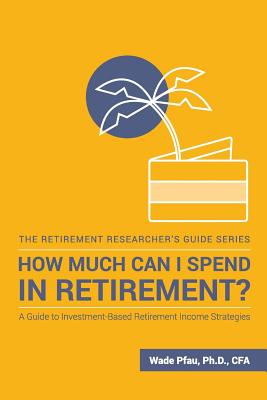How Much Can I Spend in Retirement?: A Guide to Investment-Based Retirement Income Strategies

How Much Can I Spend in Retirement?: A Guide to Investment-Based Retirement Income Strategies
How much can you spend in retirement? Naturally, this is an essential question for those approaching this important life transition. Essentially, if you wish to retire one day, you are increasingly responsible for figuring out how to save during your working years and convert your savings into sustainable income for an ever-lengthening number of retirement years. The nature of risk also changes in retirement, as the lifestyle of retirees become more vulnerable to the impacts of market volatility, unknown longevity, and spending shocks. Retirees have one opportunity to build a successful plan. It is not an easy task, but it is manageable. This book focuses on sustainable spending from investments, which is an important piece of any retirement plan. People want to know if they have saved enough to be able to fund their lifestyle in retirement. In this book, I explain the findings of a large body of financial planning research regarding sustainable spending from investment portfolios in the face of a variety of retirement risks. That body of research tends to begin with the 4 percent rule of thumb for retirement spending. I explain how and why it was developed, what it means, and when it may or may not be appropriate for retirees. William Bengen's 1994 study gave us the concept of the SAFEMAX, which is the highest sustainable spending rate from the worst-case scenario observed in the US historical data. The Trinity study added portfolio success rates from the historical data for different spending strategies. Both studies suggest that for a thirty-year retirement period, a 4 percent inflation-adjusted withdrawal rate using a 50-75 percent stock allocation should be reasonably safe. I have reservations about the 4 percent rule. It may be too aggressive for current retirees for reasons including increasing longevity, historically low interest rates coupled with higher than average stock market valuations, the impact of the international experience with the 4 percent rule casting a different light than 20th century US historical data, the need to maintain a rather aggressive asset allocation to have the best shot at success, and because the 4 percent rule assumes that investors do not pay any fees or otherwise underperform the underlying market indices. However, other factors suggest that sustainable spending may be even higher than traditional studies imply. Reasons for this include that actual retirees may tend to reduce their spending with age, that t
PRP: 174.30 Lei
Acesta este Prețul Recomandat de Producător. Prețul de vânzare al produsului este afișat mai jos.
156.87Lei
156.87Lei
174.30 LeiLivrare in 2-4 saptamani
Descrierea produsului
How much can you spend in retirement? Naturally, this is an essential question for those approaching this important life transition. Essentially, if you wish to retire one day, you are increasingly responsible for figuring out how to save during your working years and convert your savings into sustainable income for an ever-lengthening number of retirement years. The nature of risk also changes in retirement, as the lifestyle of retirees become more vulnerable to the impacts of market volatility, unknown longevity, and spending shocks. Retirees have one opportunity to build a successful plan. It is not an easy task, but it is manageable. This book focuses on sustainable spending from investments, which is an important piece of any retirement plan. People want to know if they have saved enough to be able to fund their lifestyle in retirement. In this book, I explain the findings of a large body of financial planning research regarding sustainable spending from investment portfolios in the face of a variety of retirement risks. That body of research tends to begin with the 4 percent rule of thumb for retirement spending. I explain how and why it was developed, what it means, and when it may or may not be appropriate for retirees. William Bengen's 1994 study gave us the concept of the SAFEMAX, which is the highest sustainable spending rate from the worst-case scenario observed in the US historical data. The Trinity study added portfolio success rates from the historical data for different spending strategies. Both studies suggest that for a thirty-year retirement period, a 4 percent inflation-adjusted withdrawal rate using a 50-75 percent stock allocation should be reasonably safe. I have reservations about the 4 percent rule. It may be too aggressive for current retirees for reasons including increasing longevity, historically low interest rates coupled with higher than average stock market valuations, the impact of the international experience with the 4 percent rule casting a different light than 20th century US historical data, the need to maintain a rather aggressive asset allocation to have the best shot at success, and because the 4 percent rule assumes that investors do not pay any fees or otherwise underperform the underlying market indices. However, other factors suggest that sustainable spending may be even higher than traditional studies imply. Reasons for this include that actual retirees may tend to reduce their spending with age, that t
Detaliile produsului










